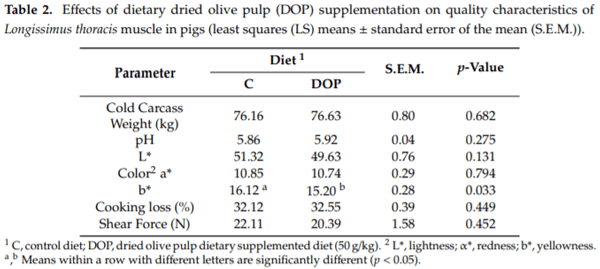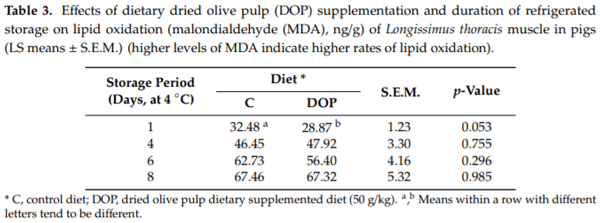Effects of Dried Olive Pulp Dietary Supplementation on Quality Characteristics and Antioxidant Capacity of Pig Meat
Olive pulp belongs to agro-industrial by-products, and its addition into livestock diets generally result in neutral or positive effects on performance. However, the data concerning the effects of olive by-products on pork meat characteristics are scarce. The aim of this preliminary study was therefore to examine the effects of dried olive pulp (DOP) dietary supplementation on quality parameters and oxidative stability of pig meat. Twenty finishing pigs were allocated to two groups: C that was provided with a control diet, and DOP that was fed with an isonitrogenous and isoenergetic diet supplemented with dried olive pulp at the level of 50 g/kg or 5%. As indicated, cold carcass weight, pH, lightness, redness, cooking loss, and tenderness were not influenced by DOP inclusion. Only meat yellowness (a*) was significantly decreased in DOP meat samples. Moreover, meat oxidation values tended to decrease in the DOP group after one day, but no further differences were observed after four, six, and eight days of refrigerated storage. It can be concluded that DOP dietary supplementation could be recommended as a feasible approach, especially in the Mediterranean region to reduce diet formulation costs, while no significant side effects on pork meat quality are observed.
Keywords: dried olive pulp; pork; meat quality; meat oxidative stability; agro-industrial by-products; sustainability



1. FAOSTAT. Available online: http://faostat3.fao.org/browse/Q/QD/E (accessed on 28 November 2019).
2. Chouchene, A.; Jeguirim, M.; Khiari, B.; Zagrouba, F.; Trouve, G. Thermal degradation of olive solid waste: Influence of particle size and oxygen concentration. Resour. Conserv. Recycl. 2010, 54, 271–277. [CrossRef]
3. Molina-Alcaide, E.; Yáñez-Ruiz, D.R. Potential use of olive by-products in ruminant feeding: A review. Anim. Feed Sci. Tech. 2008, 147, 247–264. [CrossRef]
4. Simitzis, P.E.; Deligeorgis, S.G. Agroindustrial By-Products and Animal Products: A Great Alternative for Improving Food-Quality Characteristics and Preserving Human Health. In Food Quality: Balancing Health and Disease. Handbook of Food Bioengineering, 1st ed.; Holban, A.M., Grumezescu, A.M., Eds.; Academic Press Elsevier: London, UK, 2018; Volume 13, pp. 253–290.
5. Chiofalo, B.; Liotta, L.; Zumbo, A.; Chiofalo, V. Administration of olive cake for ewe feeding: Effect on milk yield and composition. Small Rumin. Res. 2004, 55, 169–176. [CrossRef]
6. Awawdeh, M.S.; Obeidat, B.S. Effect of supplemental exogenous enzymes on performance of finishing Awassi lambs fed olive cake-containing diets. Livest. Sci. 2011, 138, 20–24. [CrossRef]
7. Mioc, B.; Pavic, V.; Vnucec, I.; Prpic, Z.; Kostelic, A.; Susic, V. Effect of olive cake on daily gain, carcass characteristics and chemical composition of lamb meat. Czech J. Anim. Sci. 2007, 52, 31–36. [CrossRef]
8. Zarei, M.; Ehsani, M.; Torki, M. Productive performance of laying hens fed wheat-based diets included olive pulp with or without a commercial enzyme product. Afr. J. Biotechnol. 2011, 10, 4303–4312.
9. Abd El-Samee, L.D.; Hashish, S.M. Olive cake in laying hen diets for modification of yolk lipids. J. Agric. Sci. Technol. A 2011, 1, 415–421.
10. Joven, M.; Pintos, E.; Latorre, M.A.; Suárez-Belloch, J.; Guada, J.A.; Fondevila, M. Effect of replacing barley by increasing levels of olive cake in the diet of finishing pigs: Growth performances, digestibility, carcass, meat and fat quality. Anim. Feed Sci. Tech. 2014, 197, 185–193. [CrossRef]
11. Ferrer, P.; Calvet, S.; García-Rebollar, P.; de Blas, C.; Jiménez-Belenguer, A.I.; Hernández, P.; Piquer, O.; Cerisuelo, A. Partially defatted olive cake in finishing pig diets: Implications on performance, faecal microbiota, carcass quality, slurry composition and gas emission. Animal. in press. [CrossRef] [PubMed]
12. Dal Bosco, A.; Mourvaki, E.; Cardinali, R.; Servili, M.; Sebastiani, B.; Ruggeri, S.; Mattioli, S.; Taticchi, A.; Esposto, S.; Castellini, C. Effect of dietary supplementation with olive pomaces on the performance and meat quality of growing rabbits. Meat Sci. 2012, 92, 783–788. [CrossRef] [PubMed]
13. Papadomichelakis, G.; Pappas, A.C.; Tsiplakou, E.; Symeon, G.K.; Sotirakoglou, K.; Mpekelis, V.; Fegeros, K.; Zervas, G. Effects of dietary dried olive pulp inclusion on growth performance and meat quality of broiler chickens. Livest. Sci. 2019, 221, 115–122. [CrossRef]
14. Luciano, G.; Pauselli, M.; Servilli, M.; Mourvaki, E.; Serra, A.; Monahan, F.J.; Lanza, M.; Priolo, A.; Zinnai, A.; Mele, M. Dietary olive cake reduces the oxidation of lipids, including cholesterol, in lamb meat enriched in polyunsaturated fatty acids. Meat Sci. 2013, 93, 703–714. [CrossRef] [PubMed]
15. Vargas-Bello-Perez, E.; Vera, R.R.; Aguilar, C.; Lira, R.; Pena, I.; Fernandez, J. Feeding olive cake to ewes improves fatty acid profile of milk and cheese. Anim. Feed Sci. Technol. 2013, 184, 94–99. [CrossRef]
16. NRC. Nutrient Requirements of Swine, 10th ed.; Natl. Acad. Press: Washington, DC, USA, 1998.
17. Botsoglou, N.A.; Fletouris, D.J.; Papageorgiou, G.E.; Vassilopoulos, V.N.; Mantis, A.J.; Trakatellis, A.G. Rapid, sensitive, and specific thiobarbituric acid method for measuring lipid peroxidation in animal tissue, food and feedstuff samples. J. Agric. Food Chem. 1994, 42, 1931–1937. [CrossRef]
18. Sas/Stat. Statistical Analysis Systems, Version 9.3; SAS Institute Inc.: Cary, NC, USA, 2011.
19. García-Casco, J.M.; Muñoz, M.; Martínez-Torres, J.M.; García-López, A.; Fernández-Barroso, M.A.; González-Sánchez, E. Alternative Feeding in Iberian Pigs during Growth Period: Incorporation of Olive Cake in a Dry or Wet (silage) Form. Agric. Conspec. Sci. 2017, 82, 147–150.
20. Branciari, R.; Galarini, R.; Giusepponi, D.; Trabalza-Marinucci, M.; Forte, C.; Roila, R.; Miraglia, D.; Servili, M.; Acuti, G.; Valiani, A. Oxidative status and presence of bioactive compounds in meat from chickens fed polyphenols extracted from olive oil industry waste. Sustainability 2017, 9, 1566. [CrossRef]
21. Branciari, R.; Ranucci, D.; Miraglia, D.; Urbani, S.; Esposto, S.; Servili, M. Effect of dietary treatment with olive oil by-product (olive cake) on physicochemical, sensory and microbial characteristics of beef during storage. Ital. J. Food Saf. 2015, 4, 5496. [PubMed]
22. Amro, B.; Aburjai, T.; Al-Khalil, S. Antioxidative and radical scavenging effects of olive cake extract. Fitoterapia 2002, 73, 456–461. [CrossRef]
23. Surai, P.F.; Fisinin, V.I. Antioxidant-prooxidant balance in the intestine: Applications in chick placement and pig weaning. J. Vet. Sci. Med. 2015, 3, 66–84.
24. Chen, W.; Ma, X.; Lin, Y.; Xiong, Y.; Zheng, C.; Hu, Y.; Yu, D.; Jiang, Z. Dietary supplementation with a high dose of daidzein enhances the antioxidant capacity in swine muscle but experts pro-oxidant function in liver and fat tissues. J. Anim. Sci. Biotechnol. 2016, 7, 43. [CrossRef] [PubMed]







